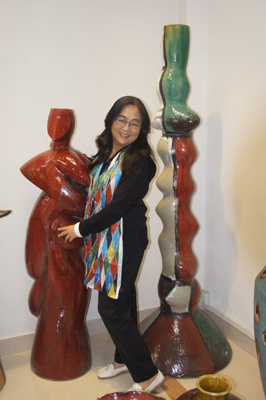In 2011, the QCC Art Gallery established a cultural exchange with the Guang Zhou Academy of Fine Arts in China resulting in the exhibition duality, a series of works in clay and bronze by sculptor and Professor Wenzhi Zhang. The artist displayed groups of cast or fired sculptures representing human figures of deeply personal interest to Zhang. These included females in progressive stages of physical decline: deeply honest representations of contemporary women in changing roles. She also created caricature-like (but clearly identifiable) Red Guard figures of the artist’s childhood, transformed into ludicrous clay figurines, starkly naked except for identifying headgear and carrying parcels of Maoist literature for distribution. Zhang also took on the vast history of Chinese myth and folklore, reconfiguring the image of the dragon to endow it with human attributes, rather than bestowing upon that august creature the more traditional traits of turtles, fish, or snakes. The special virtues attached to her sculpted forms emerge both from her imagination and subconscious levels of ancestral conventions.
Duality was an investigation into transforming political and social realities as well as the physical nature of her materials. Deliberately employing vastly different substances, she recorded her observations: bronze is ornate, clay breathes simplicity, bronze is cold, clay is passionate, bronze is cast, clay is fired. Zhang looked at the alteration of her materials when subjected to the physical extremes of casting and firing, thrilled with the chemical transformation. The exhibition fortuitously combined the notion of change across the spectrum physically, socially, and politically in a union of form and content. Here and throughout her work, Zhang deploys the language of art to reinterpret our world and to take hold of our lives and our history through the reinvention of familiar and outmoded symbols.
QCC Art Gallery is delighted to engage in a new collaboration with the artist resulting in the acquisition of forty-one of Zhang’s sculptures for our permanent collection: the New Mankind series. Her ceramic personages, a compelling amalgam of human, animal, and vegetable forms will continually inhabit the gallery’s outdoor space, an idyllic setting centrally located on campus. Visitors will find an even more welcome refuge in the Wenzhi Zhang Sculpture Garden, established in 2015.
Zhang’s New Mankind shows a strong kinship to the biomorphic abstraction found in the works of surrealist artists Joan Mir and Jean Arp. The figures, though abstracted, reflect forms found in nature. They are still growing, living presences. Standing upright, often life-sized, they are worthy of respectful regard, like garden sentries. However, they belie any impression of self-importance. Whimsical and colorful, they are casual, and in accord with their landscaped home, an inviolable place where everyone can step outside of their daily lives for peaceful interaction with nature.
Zhang’s beacons will welcome one of the most diverse populations of students as well as the community at large. Her New Mankind series re-sculpts the topography of our garden and creates meaning in a natural space. As do all exemplary works of art, Zhang’s New Mankind allows the viewer to participate in its meaning. Her personage over time will develop a patina of age from its outdoor surroundings and from engaging with a multitude of people from all nations who bring their extraordinary experiences to bear.


